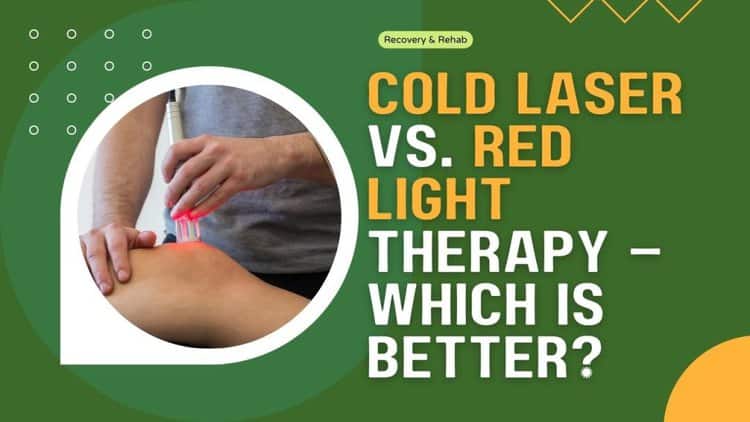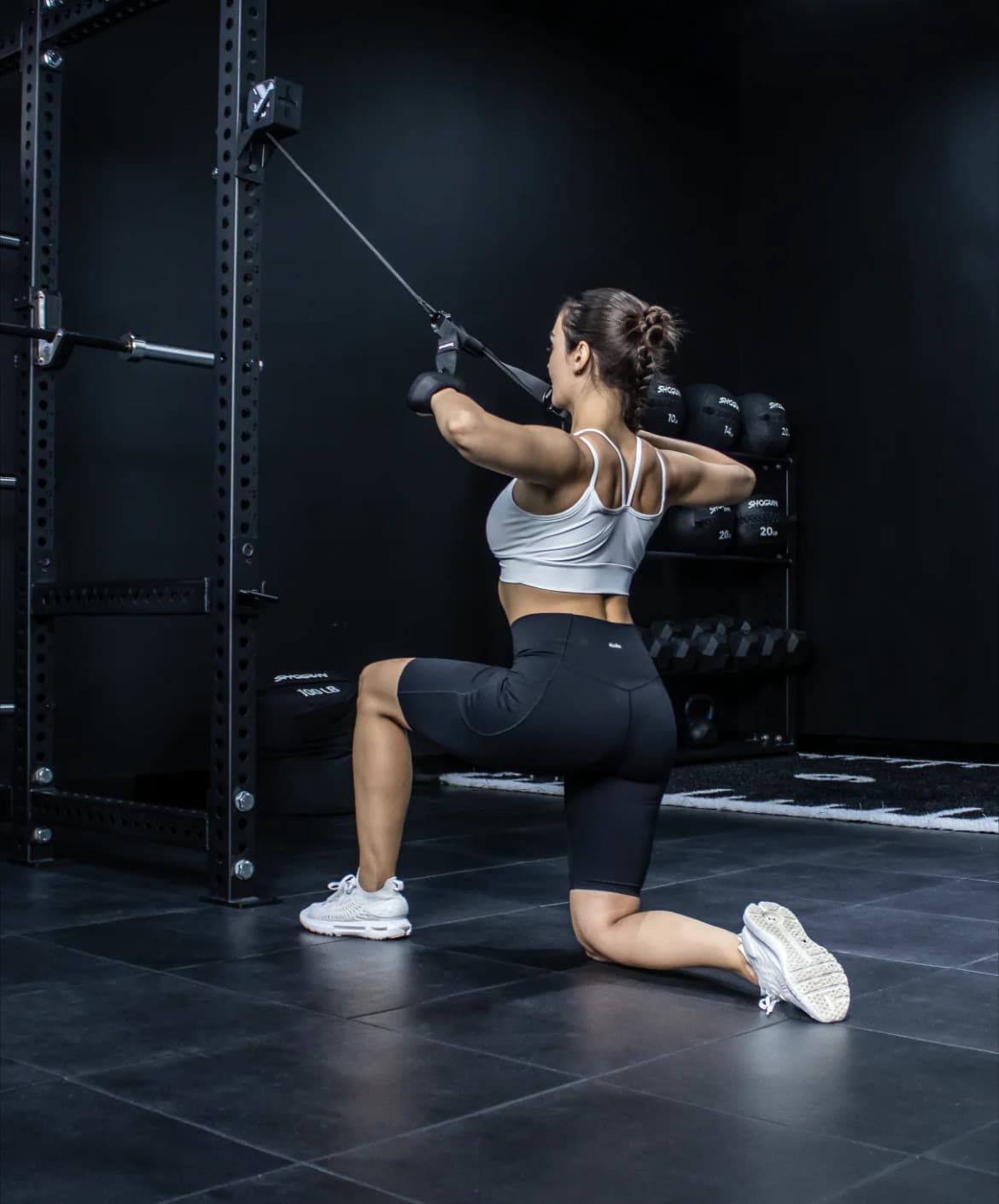Lasers are good for way more than just getting your cat to chase a red dot around, making the poor thing hilariously jump up walls and wreak havoc on furniture…
In fact, LIGHT itself has some powerful healing characteristics, with cold laser therapy and red light therapy making waves in the alternative medicine and recovery worlds.
.
Choosing between cold laser therapy and red light therapy comes down to your goals and needs, as they each have different uses and characteristics when it comes to recovery.
This is because cold laser therapy uses light-waves from a different part of the spectrum than red light therapy does.
In this article, we’ll dive into the important differences between cold laser therapy and red light therapy, exploring what the benefits of each are to help you decide which one is better for YOU.
Let’s jump in!
Red light therapy at home device
SAVE 10% with KINEON DISCOUNT CODE "A1MOVE"
Key Differences Between Cold Laser & Red Light Therapy
Cold laser therapy uses invisible light-waves that shoot deeper into your body, whereas red light therapy uses visible (red) light-waves that stay closer to the surface of the skin.
Let’s take a step back for a second and look at how this stuff actually works.
Light lives on a spectrum, with its wavelengths measured in nanometers (nm).

The lower the nm, the smaller the wavelength, and the less deep the body can absorb that light.
What Is Red Light Therapy?
Red light therapy generally uses light between 630-700 nm, which we see as the colour red – this type of light doesn’t penetrate very deep into the skin, so it’s good for improving circulation and lowering inflammation for surface-level injuries.

A lot of people will also use red light therapy for stimulating collagen production to help heal wounds and improve skin health, and even use it for promoting hair growth.https://pubmed.ncbi.nlm.nih.gov/28328705/

What Is Cold Laser Therapy?
Cold laser therapy uses light waves in the “near-infrared” range between 780-950 nm, which is invisible to us.
It’s named “cold” because the level of light is too low to warm up your body tissue, so you don’t feel any heat come from it like you can with other types of lasers used in medicine (we’ll talk more about this down below).

That means “cold laser therapy” could act as an umbrella term for all laser treatments that don’t heat up.
While that’s technically true, it’s widely agreed to differentiate red light therapy and cold laser therapy by the type of light waves they use and how deeply they get absorbed (medicine is complicated enough as it is).
Light waves in cold laser therapy can be absorbed deeper into our bodies, making them effective for treating joint and muscle injuries.
How Do Cold Laser & Red Light Therapy Work?
The way that the light and cells in both red light and cold laser therapy interact to create these treatment effects is also called “photobiomodulation.”
Research on how this type of laser therapy affects recovery and pain has been blowing up lately, with this study nicely summarizing the findings so far:
There is evidence that photobiomodulation therapy reduces pain intensity in non-specific knee pain, osteoarthritis, pain post-total hip arthroplasty, fibromyalgia, temporomandibular diseases, neck pain, and low back pain.https://pubmed.ncbi.nlm.nih.gov/34913330/
We’re constantly getting better at using this type of therapy to lower pain and reduce inflammation, while also speeding up the body’s ability to heal and recover from different injuries while avoiding drugs and more invasive methods like surgery.https://www.ncbi.nlm.nih.gov/pmc/articles/PMC6485775/
There’s actually some crazy research showing how cold laser therapy can treat chronic ulcers and spinal cord injuries, opening up some exciting doors for medicine in the future!https://www.ncbi.nlm.nih.gov/pmc/articles/PMC3643261/
Difference Between Laser & Cold Laser Therapy
Laser therapy involves a super wide range of treatments ranging from teeth-whitening to laser-eye correction to destroying cancerous tumors.
The main difference between laser and cold laser treatment is the power output, with laser therapy using much higher intensities that produce heat – people even use high-powered lasers to cut diamonds or create over-the-top villainous traps (James Bond in Goldfinger, anyone?)!

Cold laser therapy, or low-level laser therapy, doesn’t heat anything up and is used for things we mentioned above, like:
- Pain Relief
- Reducing Inflammation
- Joint Repair
So you’ll likely see cold laser therapy in physical therapy clinics and home-use laser devices, whereas the higher-powered laser therapy sticks to the hospitals and surgical clinics.
Which Therapy Is Best For Me?
It all comes down to your goals and needs…
.
Red light therapy is a better choice for skin and cosmetic reasons or to stimulate healing/pain relief in surface-level injuries.
Cold laser therapy is better for treating arthritis, joint and muscle pain/injuries, tendonitis, and deeper joint inflammation.
As an athlete, you’ll most likely want to focus on cold laser therapy since it’s more effective for muscle/tendon damage.

The deeper absorption of cold laser therapy will let you directly target your muscles and joints after putting a beating on them, which is crucial to help avoid injuries and deal with the stress your body goes through with training.
I’d recommend checking out products that lay directly on your skin rather than using panels that sit a couple inches away from you for either of these treatments – some light-waves will bounce off your skin if they’re not in direct contact!
For example, the Kineon MOVE+ is a wearable device that uses both red light AND cold laser therapy, giving you the best of both worlds (we’ll check it out in more detail down below)!
.
Also check out our full article discussing whether you should use red light therapy before or after your workout!
It’s an exciting time to get these treatments – and even have them available to us at home!
Devices We Recommend
Here are a couple devices for both red light therapy and cold laser therapy that you can use at home!
Red light therapy at home device
SAVE 10% with KINEON DISCOUNT CODE "A1MOVE"
Kineon MOVE+ Pro
The Move+ Pro is hands down the best red light therapy device for home use right now, especially for athletes.
The MOVE+ is one of the few devices that use both red light and cold lasers!
I’ve tried red light panels, handhelds, and towers, but the Kineon MOVE+ is a wearable device that has been the biggest game changer in my recovery using red light therapy.
It has 3 separate modules that are wrapped around whatever joint or muscle you’re targeting, giving you a 360º treatment while being in direct contact with the skin.
Each of the 3 modules have 8 red light LEDs at 650 nm and 10 infrared lasers a 808 nm, giving you full-joint coverage and treating skin-to-joint all at once!
The best thing is you can easily use it for your knee, elbow, back, shoulder, neck, ankle… the list goes on.
It’s perfect if you’re always on the move or want an alternative to icing and foam rolling!
It’s the ideal red light device for muscle recovery!
.
Check out our full Kineon Move+ Pro review!
Don’t forget to use discount code A1ATHLETEMOVE+ at checkout to get 10% off your MOVE+!
Terraquant TQ Solo Ultimate Cold Laser System
This is a handheld device that’s been recommended for cold laser therapy by several professionals in the field.
While the Kineon MOVE+ simultaneously treats with red light and cold laser therapy, the Terraquant TQ Solo Ultimate is the best option if you want to use wavelengths all the way up to 905 nm.
One of the cool things about this laser is that they have an exclusive app that shows you different protocols for various injuries and the research behind this stuff.
It’s insanely expensive though, and about 5 times the price of the Kineon MOVE+!
Still, if you’ve got the cash and want the best possible cold laser therapy from the convenience of your own home, this is about as good as it gets!
Conclusion
Red light therapy and cold laser therapy are separated by how deep their light waves are absorbed into the body, effectively changing what part of the target site is being treated.
Red light therapy is great for pain-relief in surface-area injuries, promoting blood flow superficially, healing wounds, and for cosmetic/hair growth reasons.
Cold laser therapy targets the deeper structures like joints and muscles, perfect for reducing pain, improving recovery, and healing injuries.
You should choose the one that best fits your needs and goals, as they’re both great recovery tools – they just need to be used for the proper depth!


























